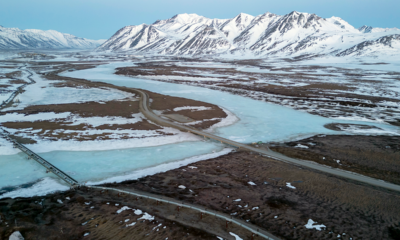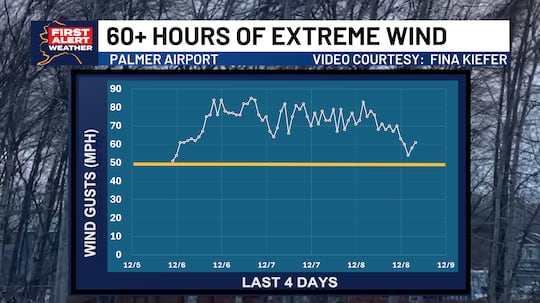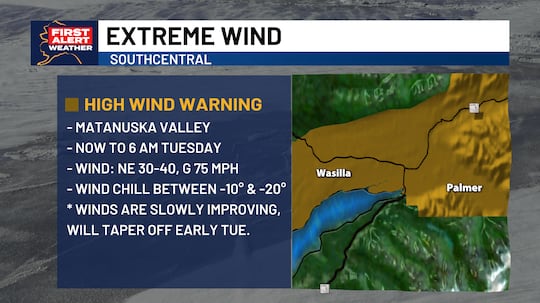Alaska
Amid Alaskan Glaciers, a Possible ‘Death Spiral’

Since the late 1700s, the Juneau Ice Field, interconnected glaciers that stretch across 1,500 square miles of Alaska and British Columbia, has lost about a quarter of its volume. But it’s an “incredibly worrying” phenomenon that took place between 2010 and 2020 that has scientists especially concerned: The remote swath, which features the famous Mendenhall Glacier, dropped 1.4 cubic miles of ice annually during that decade-long period, double the rate of ice melt before 2010, reports the New York Times. In their study published Tuesday in Nature Communications, researchers add that rates of “area shrinkage” were five times faster from 2015 to 2019 than they were from 1979 to 1990.
The team led by Newcastle University glaciologist Bethan Davies pulled together decades of glacial measurements using aerial views, surveys, maps, and satellite imagery, supplementing that with in-the-field verification and research into tree rings and peat to try to figure out previous environments in the ice field. What they found was that every single one of the area’s 1,050 glaciers receded between 1770 and 2019, with 108 glaciers vanishing altogether; dozens of new lakes formed as a result. Scientists say the melt is affected by tourism; soot from wildfires that lands on the ice and expedites melting; and the wide, flat surface of thinning ice that further exposes it to warming air, among other factors.
Just because Alaska is a far-flung spot for most of the planet’s inhabitants, the glacial melt there matters “tremendously,” per the Times, which notes that “in no other region of the planet are melting glaciers predicted to contribute more to global sea-level rise this century.” Plus, scientists fear that ice fields elsewhere, including in Greenland, Norway, and other Arctic-adjacent locations, could meet the same fate, per Reuters. Global warming will likely continue to further exacerbate the situation, with one climatologist warning of a possible “death spiral” for the glaciers, per the AP. “If we reduce carbon, then we have more hope of retaining these wonderful ice masses,” Davies tells the Times. “The more carbon we put in, the more we risk irreversible, complete removal of them.” (More glacial melt stories.)

Alaska
‘Alaska is a dangerous place’: How Whittier Harbor stays safe during the winter

ANCHORAGE, Alaska (KTUU) – Winter season brings its risks in harbors across Alaska – including sinking boats, ice, and wind.
“Alaska is a dangerous place,” David Borg, Whittier Harbor Master said. “Here we have massive amount of wind and coming down here in the wintertime with icy docks and a lot of wind, it’s very easy for people to lose their footing.”
Borg also talked about something called SAD – which stand for ‘Sunk At Dock’.
“Boat sinking at the dock. We do have an issue with snow load here,” Borg said. “Best thing people can do … is that if you have a boat in the harbor, you have to have somebody local that can keep an eye on it.”
At Whittier Harbor, safety holds importance all year round.
“If I can make it a little bit safer here in the harbor – so you and your family can go out and boat and do those things that Alaska has to offer safely – then I’d like to try to push that message as best I can,” Borg said
Borg urges anyone who visits Alaska harbors in the winter to know the conditions, gear up properly, and always put safety first.
See a spelling or grammar error? Report it to web@ktuu.com
Copyright 2025 KTUU. All rights reserved.
Alaska
Alaska Airlines launches new nonstop Seattle-to-London flight starting in 2026

Alaska Airlines announced its newest nonstop flight out of Seattle: a straight shot to London.
Starting in May 2026, the nonstop flight will travel from the Seattle-Tacoma International Airport (SEA) to Heathrow Airport, the largest international airport in the United Kingdom. The airport resides in Hounslow, located an hour outside of London.
The daily service will operate on Alaska Airlines’ 787 Dreamliner.
London is Alaska Airlines’ fifth intercontinental destination, alongside Rome, Reykjavik, Tokyo, and Seoul. According to the airline, the new route strengthens business ties, with London being the largest corporate market from Seattle.
“By 2030, we plan to serve at least 12 intercontinental destinations from Seattle, with additional routes to be announced in the years to come,” Alaska Airlines stated. “We currently have four Boeing 787-9s in our fleet, with a fifth aircraft recently delivered.”
Guests traveling from the U.S. can now purchase airfares to London for as low as $699 round-trip at alaskaair.com.
Alaska Airlines hit hard by federal shutdown
According to aviation analysts, the federal shutdown cost Alaska Airlines millions of dollars. The airline’s fourth-quarter income is expected to fall by $32 million.
The company told investors it lost 15 cents per share. Flight cancellations at SEA and other airports lasted 43 days.
According to The Puget Sound Business Journal, Delta reports a $200 million hit. United, JetBlue, and Southwest could see losses, too.
Follow Frank Sumrall on X. Send news tips here.
Alaska
Warnings continue for wind, snow, and extreme cold across Alaska

ANCHORAGE, AK (Alaska’s News Source) – Extreme wind has been non-stop for more than 60 hours in Wasilla in Palmer, where peak wind gusts have reached over 80 mph three days in a row.
Wind gusts at the Palmer Airport climbed over 50 mph Friday evening and didn’t drop below until late Monday evening.
The High Wind Warning for the Matanuska Valley will continue through 6 a.m. on Tuesday. Calmer conditions are likely on Tuesday afternoon as the winds relax across the area.
Send us your weather photos and videos here!
The rest of Southcentral remains clear and dry, with temperatures likely dropping to the lowest levels of the season starting Tuesday morning. This pattern will continue through the end of the week.
Download the free Alaska’s News Source Weather App for the latest forecast in your area.
In Southeast, Winter Storm Warnings are still in effect near Ketchikan for up to 8″ of additional snow through Tuesday. Winter Weather Advisories are also in effect near Hyder for an additional 9-12″ of snow on Tuesday.
The snow has ended across the northern areas of Southeast, but extreme cold is setting in. Wind Chill values will reach as low as -50° near Skagway, to -25° near Haines, and to -15° near Juneau.
The Copper River Basin will also experience extreme wind chill values to -50° through Tuesday afternoon.
In the Interior, temperatures dropped to -30° for the first time Monday morning, and we’ll see several nights at that cold level this week.
24/7 Alaska Weather: Get access to live radar, satellite, weather cameras, current conditions, and the latest weather forecast here. Also available through the Alaska’s News Source streaming app available on Apple TV, Roku, and Amazon Fire TV.
Copyright 2025 Alaska’s News Source. All rights reserved.
-

 Alaska4 days ago
Alaska4 days agoHowling Mat-Su winds leave thousands without power
-

 Politics1 week ago
Politics1 week agoTrump rips Somali community as federal agents reportedly eye Minnesota enforcement sweep
-
Ohio7 days ago
Who do the Ohio State Buckeyes hire as the next offensive coordinator?
-

 News1 week ago
News1 week agoTrump threatens strikes on any country he claims makes drugs for US
-

 World1 week ago
World1 week agoHonduras election council member accuses colleague of ‘intimidation’
-

 Texas5 days ago
Texas5 days agoTexas Tech football vs BYU live updates, start time, TV channel for Big 12 title
-

 Iowa3 days ago
Iowa3 days agoMatt Campbell reportedly bringing longtime Iowa State staffer to Penn State as 1st hire
-

 Miami, FL4 days ago
Miami, FL4 days agoUrban Meyer, Brady Quinn get in heated exchange during Alabama, Notre Dame, Miami CFP discussion






















